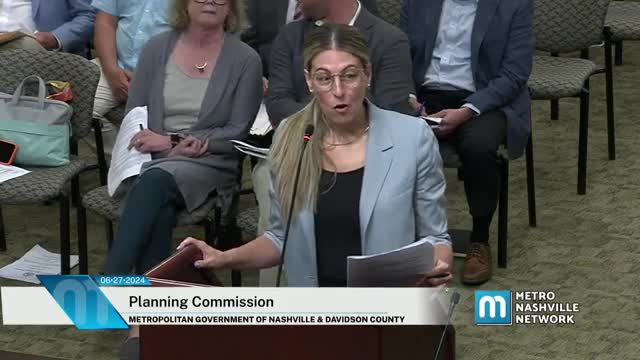Community rallies for Richland Creek development amid traffic concerns
June 28, 2024 | Planning Commission Meetings, Nashville, Davidson County, Tennessee

This article was created by AI summarizing key points discussed. AI makes mistakes, so for full details and context, please refer to the video of the full meeting. Please report any errors so we can fix them. Report an error »

In a recent government meeting, discussions centered around the proposed Richland Creek development project, which aims to transform a shopping center into a mixed-use residential area. The project has garnered both support and opposition from local residents, highlighting the complexities of urban development in Nashville.
Proponents of the project, including local residents and community leaders, emphasized the need for improved infrastructure and increased housing options in the area. Supporters noted that the development would enhance pedestrian safety, provide better access to amenities, and improve transportation options, including the addition of new bus stops, crosswalks, and a marked bikeway. Many expressed excitement about the potential for a safer and more walkable community, particularly for families and individuals who frequent nearby shopping locations like Trader Joe's and Target.
Courtney Leys, a resident and supporter, highlighted the project's potential to create a safer environment for pedestrians, while others echoed sentiments about the need for diverse housing options to accommodate Nashville's growing population. Residents like Chelsea Cahill and Laura Lee Dobie praised the developer's responsiveness to community feedback and the project's alignment with the city's goals for sustainable growth.
However, opposition to the project was also vocal, with concerns primarily focused on traffic congestion and the adequacy of existing infrastructure. Residents from the nearby Lionshead condominiums expressed fears that the increased traffic from the new development would exacerbate existing issues, particularly at the single exit point from their community. Critics argued that the project could hinder access to the Richland Creek Greenway and create further complications for emergency services navigating the area.
Several residents called for a comprehensive traffic study to assess the potential impacts of the development before any approvals are granted. They urged the council to consider the cumulative effects of multiple ongoing developments in the vicinity, which they believe could overwhelm the current infrastructure.
As the public hearing concluded, the council was left to weigh the benefits of increased housing and improved community amenities against the valid concerns regarding traffic and infrastructure. The outcome of this project will likely set a precedent for future developments in Nashville, as the city grapples with balancing growth and community needs.
Proponents of the project, including local residents and community leaders, emphasized the need for improved infrastructure and increased housing options in the area. Supporters noted that the development would enhance pedestrian safety, provide better access to amenities, and improve transportation options, including the addition of new bus stops, crosswalks, and a marked bikeway. Many expressed excitement about the potential for a safer and more walkable community, particularly for families and individuals who frequent nearby shopping locations like Trader Joe's and Target.
Courtney Leys, a resident and supporter, highlighted the project's potential to create a safer environment for pedestrians, while others echoed sentiments about the need for diverse housing options to accommodate Nashville's growing population. Residents like Chelsea Cahill and Laura Lee Dobie praised the developer's responsiveness to community feedback and the project's alignment with the city's goals for sustainable growth.
However, opposition to the project was also vocal, with concerns primarily focused on traffic congestion and the adequacy of existing infrastructure. Residents from the nearby Lionshead condominiums expressed fears that the increased traffic from the new development would exacerbate existing issues, particularly at the single exit point from their community. Critics argued that the project could hinder access to the Richland Creek Greenway and create further complications for emergency services navigating the area.
Several residents called for a comprehensive traffic study to assess the potential impacts of the development before any approvals are granted. They urged the council to consider the cumulative effects of multiple ongoing developments in the vicinity, which they believe could overwhelm the current infrastructure.
As the public hearing concluded, the council was left to weigh the benefits of increased housing and improved community amenities against the valid concerns regarding traffic and infrastructure. The outcome of this project will likely set a precedent for future developments in Nashville, as the city grapples with balancing growth and community needs.
View full meeting
This article is based on a recent meeting—watch the full video and explore the complete transcript for deeper insights into the discussion.
View full meeting
